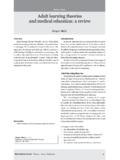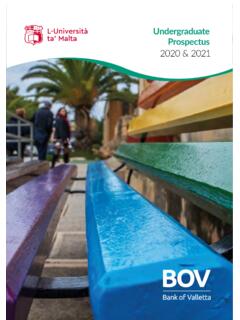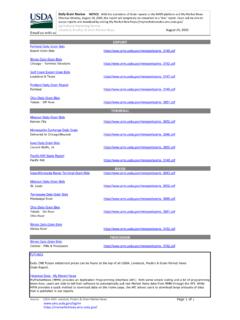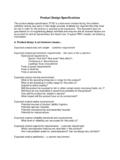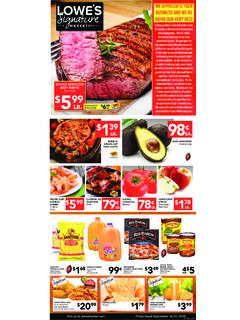Transcription of Market Segmentation Targeting and Positioning
1 1 Market Segmentation , Targeting and Positioning By Mark Anthony Camilleri1, PhD (Edinburgh) How to Cite: Camilleri, M. A. (2018). Market Segmentation , Targeting and Positioning . In Travel Marketing, Tourism Economics and the Airline Product (Chapter 4, pp. 69-83). Springer, Cham, Switzerland. Abstract Businesses may not be in a position to satisfy all of their customers, every time. It may prove difficult to meet the exact requirements of each individual customer. People do not have identical preferences, so rarely does one product completely satisfy everyone. Therefore, many companies may usually adopt a strategy that is known as target marketing. This strategy involves dividing the Market into segments and developing products or services to these segments. A target marketing strategy is focused on the customers needs and wants. Hence, a prerequisite for the development of this customer-centric strategy is the specification of the target markets that the companies will attempt to serve.
2 The marketing managers who may consider using target marketing will usually break the Market down into groups (segments). Then they target the most profitable ones. They may adapt their marketing mix elements, including; products, prices, channels, and promotional tactics to suit the requirements of individual groups of consumers. In sum, this chapter explains the three stages of target marketing, including; Market Segmentation (ii) Market Targeting and (iii) Market Positioning . Introduction Target marketing involves the identification of the most profitable Market segments. Therefore, businesses may decide to focus on just one or a few of these segments. They may develop products or services to satisfy each selected segment. Such a target marketing strategy differs from mass marketing (where a company may decide to produce and distribute one product to all consumers) or from product differentiation (where a company offers a variety of products to a large Market ).
3 Marketers have been moving away from mass marketing endeavours, as they are increasingly Targeting smaller segments with customised marketing programmes. In 1 Department of Corporate Communication, Faculty of Media and Knowledge Sciences, University of Malta, Msida, MSD2080, MALTA. Email: 2 this light, this chapter sheds light on the process of Market Segmentation . It clarifies how businesses could select the most profitable segments as they employ Market coverage and Positioning strategies to attract them. The Market Segment A Market segment is a group of individuals, groups or organisations who may share the same interests, traits and characteristics. The consumer segments may have similar needs, wants and expectations. Therefore, businesses should ask themselves which segments should they serve? To answer this question, the businesses must determine the most appropriate ways to distinguish and to differentiate their segments.
4 Once the segments have been identified they must customise their offerings to satisfy each and every one of them. Market Segmentation Market Segmentation is the actual process of identifying segments of the Market and the process of dividing a broad customer base into sub-groups of consumers consisting of existing and prospective customers. Market Segmentation is a consumer-oriented process and can be applied to almost any type of Market . In dividing or segmenting markets, researchers typically look for shared characteristics such as common needs, common interests, similar lifestyles or even similar demographic profiles. So, Market Segmentation assumes that different segments require different marketing programmes, as diverse customers are usually targeted through different offers, prices, promotions, distributions or some combination of marketing variables. For example, Southwest Airlines single-minded focus on the short-haul, point-to-point, major-city routes, allowed them to prosper as their competitors floundered.
5 The airline s focus on specific segments allowed them to do a better job of deciding what their target segment really valued (for example, convenience, low price, on-time departures and arrivals, among other things). Once the customer segments have been identified and profiled, the marketer must decide which segment to target. Diverse customers will have different expectations. For instance, there may be customers who will value a differentiated, high quality service, whilst others may be more price-sensitive. Notwithstanding, not all firms have the resources to serve all customers in an adequate manner. Trying to serve the entire Market could be a recipe for disaster. The overall aim of Segmentation is to identify high-yield segments. These are likely to be the most profitable groups of customers, or may hold potential for growth. Hence, the most lucrative 3 segments will usually become target markets. In the tourism industry, the business traveller is usually considered as an attractive segment.
6 However, there are different types of business travellers: The hard Money Travellers (or the independent business travellers), these include the business individuals travelling at their own expense; The soft Money Travellers (or corporate business travellers), these include business individuals travelling on an expense account; The Medium Money Travellers (or the conference or incentive business travellers), these include business individuals travelling within a group; The Interim Travellers, these include business travellers who are combining personal travel with a business trip; The Frequent Short Travellers, these include business travellers who consistently fly a short-haul route; The Periodic Travellers, these include sales persons who make a round of stops on a steady itinerary. However, these six groups are said to be only part of some other travel groupings which have often been identified as principal sources of revenue for the tourism industry.
7 Travel and tourism marketers must analyse these various segments. They must then select at least one segment and decide how to service them, in terms of fare prices, facilities, frequencies and special features. The Benefits of Segmentation By dividing the Market into segments, marketing managers can acquire a better understanding of the needs and wants of customers. This enables them to customise or to tailor the company s marketing activities more accurately and responsibly to the individual customers likings. Segmentation marketing supports businesses in meeting and exceeding their customers requirements. It may also allow them to evaluate the competitors strengths and weaknesses. This way, they could discover business opportunities in markets which were not served well. Customer Segmentation enables marketers to adopt a more systematic approach when planning ahead for the future. This leads to better exploitation of marketing resources, resulting in the 4 development of a more finely-tuned marketing programme.
8 For example, the businesses integrated marketing communications can be better organised, as targeted advertising (for example native advertising) and promotional activities can be directed at individual customers. For example, the emergence of data-driven, digital technologies such as sensor analytics, geo-location and social data-capture could track the users movements and other real-time phenomena. These disruptive technologies are increasingly being used by tourism businesses as they add value to customer-centric marketing endeavours (Schegg & Stangl, 2017; Camilleri, 2016). Segmentation Variables Having defined Segmentation and discussed about its benefits, the next question to address is; how could businesses segment their markets? The traditional variables that may be used for Market Segmentation can be grouped into five main categories: (i) Demographic; (ii) Geographic (iii) Psychographic; (iv) Behavioural and / or (v) Product-Related Factors.
9 Demographic Segmentation Demographic Segmentation involves dividing the Market into groups that are identifiable in terms of physical and factual data. The demographic variables may include; age, gender, income, occupation, marital status, family size, race, religion and nationality. These Segmentation methods are a popular way of segmenting the customer markets, as the demographic variables are relatively easy to measure. For example, the age range for business travellers may usually span from their late twenties to their mid-fifties. According to Skift (2017), younger employees are travelling for business purposes and their buying habits are completely different than their older counterparts. On average, millennials took business trips in the last year, compared to for Generation Xers and for baby boomers. Younger travellers are less likely to book air travel based on loyalty programme perks.
10 They are more likely to book their flight according to the airline service and the customer experience they offer. Moreover, young travellers are more likely to use room share services like Airbnb, than other segments (Skift, 2017). However, for the time being, major hotel brands are not under any serious threat. 5 At the same time, Uber and other ridesharing services are becoming mainstream across all age groups, as they may be cheaper than taxis (Pew Research, 2016). The age range in the leisure Market is a very broad one and quite different to that in the business Market . Children particularly can play an important role in leisure travel, as they travel abroad on holidays with their families. Young people in their early to mid-twenties too are prepared to spend their disposable income on travel before they take on the responsibilities of family life. At the other end of the scale, we have those who are retired from work, are in a relatively good health and in good financial position which allows them to travel.
